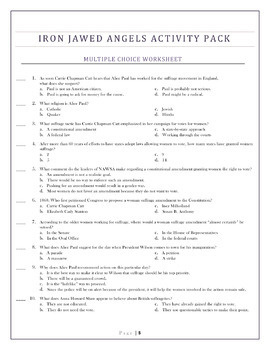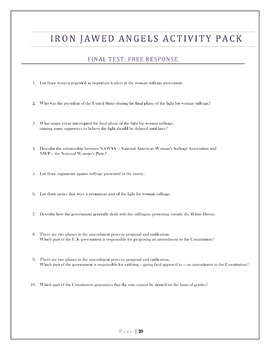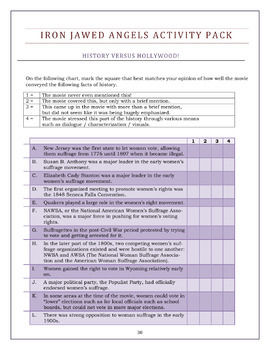Iron Jawed Angels Worksheet and Activity Pack: Suffrage Film Worksheets
- PDF
Description
Viewing worksheet, tests, crossword puzzles, and analysis activity -- all designed for use with Iron Jawed Angels, an excellent HBO movie detailing the women’s suffrage struggle in the early 20th century.
The film lasts two hours and five minutes including the credits sequence at the end. This means that it can be shown in two class periods in a typical high school. I usually allot three days to see the film, however, since that leaves ample time for discussion and to get started on some of the fun activities included in this packet.
ABOUT THESE IRON JAWED ANGELS WORKSHEETS
A large number of activities are included for use with the film.
1) Multiple choice worksheets in movie order. These have 100 questions for students to answer while viewing the movie. Some teachers might want to let students watch the movie without them, but give them time at the end of each class period to answer the relevant portion of the question set. Alternately, the questions can be assigned to do for homework after each day’s movie viewing. They can even be used as a comprehensive test after the entire movie has been watched.
2) Multiple choice test. This has 10 questions only, and they are *not* drawn from the set of 100 questions on the worksheet. Instead, these 10 questions are “big idea” items – things that any student should definitely have mastered after watching the movie. (The 100 worksheet questions are considerably more detailed). Some teachers might want to use the 10 question test as a differentiated learning worksheet.
3) Free response test. This has 10 questions and is a free-response variant of item #2, meaning that the questions are identical or similar. Two tests means more opportunities to differentiate – some teachers might want to use item #2 for basic learners and reserve the harder version of the test for students who work at a higher level.
4) Two crossword puzzles differentiated by difficulty. Each is provided both with and without a word bank to allow teachers to differentiate further even within the two levels.
5) History versus Hollywood worksheet. This critical thinking and evaluation worksheet asks students to consider how well the movie accomplished the aim of communicating accurately the history of the women’s suffrage struggle in the United States.
TEACHER CONVENIENCE FEATURES IN THESE IRON JAWED ANGELS WORKSHEETS
I’m a teacher too, so I’m always looking for ways to become more efficient so I can get it all done and still have a reasonable work-life balance. To that end, I’ve built several handy features into these Iron Jawed Angels Activities.
• Answer sheet for multiple choice worksheet, with the answer key exactly matching the answer sheet format. If students write their answers down on these, they can be corrected very rapidly by lining up the key with several student answer sheets at once. Plus, it will mean that teachers can use the 100-question worksheet over and over since students won’t need to mark on it.
• Detailed options and ideas for how to use the worksheets, crossword puzzles, and History vs. Hollywood Activity. Lots of instructional choices to select from so they suit your pacing and teaching style!
• Two different crossword puzzles for differentiating.
• Two levels of difficulty included for each crossword puzzle for even more differentiating.
• Helpful annotations to assist teachers discussing the History vs. Hollywood activity with their students.
IDEAS FOR USING THESE IRON JAWED ANGELS MOVIE WORKSHEETS
Only a teacher knows what constitutes best use for a particular class, but I always find it helpful to see what creative approaches other teachers are using. Here are some good options for the 100-question multiple choice worksheet, the 10-question multiple choice test, and the 10-question free response test.
• Standard use: Print off copies and have students complete them as they watch the film. Or send the copies electronically so students can complete them on tablet/laptop devices, if that is an option in your setting. Go over answers out loud if time permits (great for discussing/debriefing the film content) or collect papers to grade them more formally.
• Accommodate students who claim that the worksheets "go too fast:" Assign students to do only the evens or only the odds. After watching the film, pair students up to discuss and fill in missing answers.
• Create basic and advanced levels from the same worksheet: This is easily done by declaring that the "basic" level is odds-only (or evens-only) while the "advanced" level consists of all the questions. Encourage students to challenge themselves to do the advanced level by offering extra credit or by announcing that the basic level can only earn a C at best, but A and B grades are available at the advanced level.
• Run a game show: Have students watch the film carefully and take notes. Form groups afterwards and have them pool their notes, briefly discussing the whole film. Pass out the worksheets only AFTER this discussion and have each group fill out one collaboratively. Go over the answers out loud, calling on groups to respond. This option means making fewer copies: one per group instead of one per student.
• Run a multi-round game show: Print out only one copy of the worksheet and cut it apart to make question strips. Have students watch the film carefully and take notes. Form groups afterwards and have them pool their notes, briefly discussing the whole film. Ask the questions out loud, handing the question slip used to the group that first supplies the correct answer. In this way the question strips become a point counter to keep track of group progress. After all questions have been used, have each group ask each of their questions of the other groups -- this provides an additional level of review and gives groups a chance to recoup points they missed on the first round. This option means making only a single copy!
• My personal favorite -- Let students self-assess their learning: Print out one worksheet per student, but hang onto them until students have finished watching the film. Then pass them out and have students work in pairs or individually to see how much they remember. Then go over the material aloud to review with the class and let them fill in the blanks.
• Use worksheets as a traditional quiz: As above, but collect papers for grading before going over the items aloud.
ABOUT THE CROSSWORD PUZZLES
Two crossword puzzle activities are included for use with the movie. Both of them are intended for use after the entire film has been viewed.
Crossword Puzzle A is intended for students who need a “basic” level activity. It has fewer problems to solve and has clues restricted to items that are easier to recall from the film. For even further differentiation, the puzzle is presented both with and without a word bank.
Crossword Puzzle B is more challenging. It includes all of the items from Puzzle A, but it adds on several more that are of a higher difficulty level. Like Puzzle A, it is presented both with and without a word bank so that teachers can use it on a differentiated learning basis should they desire.
Usage Ideas:
• Use only Puzzle A or Puzzle B in a given class depending on overall student need.
• In the same class, have some students complete Puzzle A while others do Puzzle B depending on individual student need.
• Have students complete Puzzle B as a practice activity, going over all the answers with the class. Then assign Puzzle A as a quiz. This approach allows students a chance to review, but then expects them to remember only the most essential information for their quiz score.
• Allow students to choose which puzzle they will do, easy or hard, but tell them that if they choose the easy puzzle, they can only earn a C at best, while those who do well on the hard puzzle can earn a grade of A or B.
• Allow students to choose which puzzle they will do, easy or hard, but tell them that the hard puzzle can result in extra credit points.
ABOUT THE HISTORY VERSUS HOLLYWOOD ACTIVITY
This activity is designed to help students analyze the movie and engage their critical thinking skills. Although it helps students compare movie events to the real-life facts of the women’s suffrage struggle, it is rather unique in that it does not require students to possess any accurate background knowledge at all. Instead, they will gain that knowledge as they work their way through the activity.
The activity consists of a series of completely true factual statements about the real-life suffrage movement. Students are asked to evaluate such statements on the basis of how well the movie communicated the information embedded in each. Statements range from ones that the movie covered extremely well, such as “In the early 20th century, there were two competing woman suffrage organizations: NAWSA and NWP. Their leaders were hostile to one another” to ones the movie didn’t cover at all, such as “A major political party, the Populist Party, had officially endorsed women’s suffrage.”
By analyzing the key statements, students will learn about historical events which the movie obscured or left out. They will also learn the many ways in which Iron Jawed Angels is a highly accurate historical film!
This activity is intended for use only after the entire film has been viewed.
An answer key with useful annotations is included for teacher reference, but since this activity is to some extent opinion-based, answers on the key should be taken with a grain of salt. As long as students can defend their opinions well, they should be regarded as valid and acceptable.
Usage Ideas
• Assign the student worksheets to individuals to complete, then pair them up to compare answers and reach a consensus for each pair. This should cue paired discussion and a lot of good thinking! Afterwards, go over answers with the class and take a poll of how many students rated a given item as a “1,” “2,” “3,” or “4.” (See worksheet on next page for a key to what these numbers mean.)
• Divide the class into groups of three or four students, and print off just one worksheet per group. Proceed as above. The approach is very similar except that with this procedure, students are debating and discussing from the start instead of having individual time to ponder first. This approach has the advantage of using less paper and prep time since fewer copies are needed.
• After either of the above approaches, ask individual students or groups to choose one or two items from their “not included in the movie at all” lists. Then have them provide an explanation as to how they would include that information if they were the screenwriter. This assignment can be as casual or formal as the teacher desires. Some might just want students to verbally describe their ideas for augmenting the movie, while others might require students to complete a short section of a script – either one adding onto an existing scene, or one that creates a completely new scene for the movie.
• Building onto the above idea, some teachers might want to choose for themselves the ONE item they would like to see students work into the movie. Teachers can then assign groups to come up with an idea for how to work it in, and each group can present. It should be interesting to see the varied approaches the students come up with. Optionally, the class can vote on which approach they find to be the most viable – allowing a “pick your top three” vote will keep the tally from being completely skewed by group members only voting for their own idea.
Happy teaching,
Elise Parker
Keywords:
Lucy Burns, Elizabeth Cady Stanton, force-feeding, Susan B. Anthony, National Woman's Party, NWP, Yellow Roses, NAWSA, National American Woman's Suffrage Organization, Ida Wells-Barnett, Ida B. Wells, Political Prisoners, Woman's Suffrage Procession, Woman's Suffrage Parade, Hunger Strike, Carrie Chapman Catt, Treason, 19th Amendment, Nineteenth Amendment, Woodrow Wilson, WWI, First World War, World War I, Constitutional Amendment, Congress





